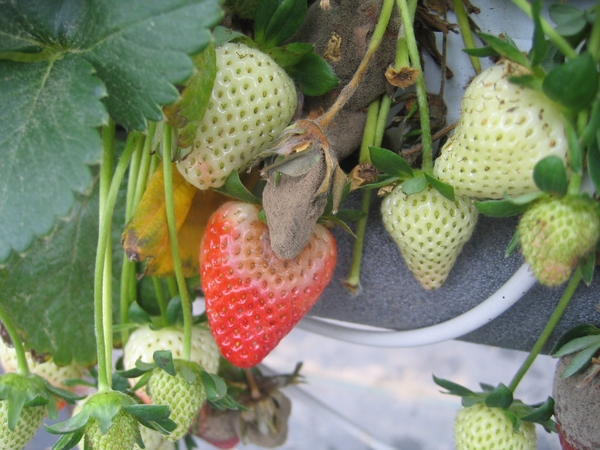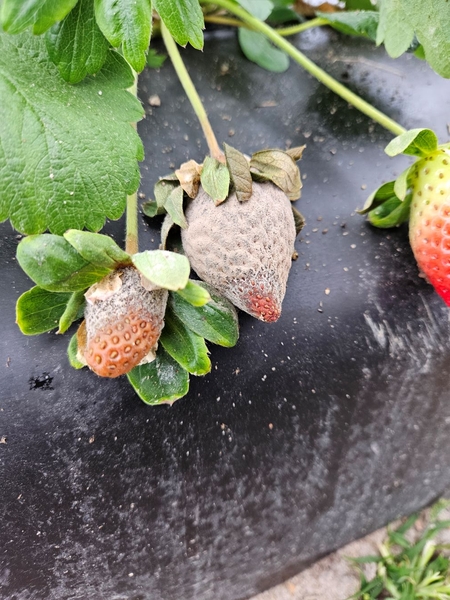Introduction
Gray mold, or Botrytis Fruit Rot, is a serious fungal disease caused by Botrytis cinerea. In most years it is the primary disease of concern for strawberries and is present in all strawberry production areas. The disease is a problem not only in the field, but also post-harvest during storage, transit, and marketing of strawberries, due to onset of severe rot as the fruits begin to ripen. Besides fruit, the fungus also infects leaves, crown, petals, flower stalks, and fruit caps. Specifics on Botrytis Crown rot can be found in the Extension factsheet: Botrytis Crown Rot of Strawberry. Disease is most severe during bloom and harvest in cool seasons with lengthy periods of clouds and rain.
Signs and Symptoms
Gray mold often infects petals and leaves before fruit set and may be prevalent during all stages of fruit development. Infected petals may not develop symptoms until flowers drop and fruit begins to develop. The fungus then progresses down to the developing fruit causing light brown lesions at the stem end that quickly spread. Initial fruit infections can also occur where they contact soil, standing water, or other infected berries and flower petals. Infected fruit may remain firm, yet become covered with gray spores and mycelium, giving the fruit a velvety gray appearance. High humidity favors mycelial formation that is visible as a white cottony mass. On undeveloped fruit and under dry conditions, lesions may develop slowly, and fruit may become misshapen and die before maturity. Fruits that are completely rotten become dry, tough and mummified.
Disease Cycle
Botrytis primarily enters the field on transplant foliage. The fungus can live in the green tissue (leaves, stems, etc.) but be latent, or dormant, and not cause symptoms. Botrytis can affect many different crops and therefore weeds surrounding a field could be an important source of the pathogen. The pathogen can also produce dark hardened structures called sclerotia (overwintering structures of the fungus) and these can persist in soil for years. However, experiments conducted in eastern North Carolina showed no signs of Botrytis on surrounding vegetation and found no indication of sclerotia in the soil. This suggests that those sources may be of limited importance in North Carolina for the spread of disease. In the presence of cool, wet weather with prolonged leaf wetness (13-16 hours) the infected strawberry tissue begins to die, and the pathogen becomes active. It colonizes the leaf and begins obtaining its nutrients from the dead tissue. Spores are formed from these colonized tissues and, once environmental conditions are appropriate (between 65-75 F and damp or rainy weather), they are dispersed by water splash and/or wind onto newly emerging leaves or blossoms. With free moisture, the spores can germinate and begin new infections. Immature fruits become infected primarily through blossom infections as the fungus spreads from flower to fruit tissues. Once the berries begin to ripen, the fungus colonizes them and sporulates, producing the characteristic “gray mold”. Any of these infected tissues become sources for secondary infections in the field. Spring frosts may increase the possibility of flower and fruit infections as the damaged blooms are an ideal infection court. During storage, transport, and other post-harvest situations symptoms can appear after days or weeks on seemingly healthy fruit due to latent infections. These infections spread quickly through contact and on wounds from handling.
Factors of plant growth that are most important for disease development in annual planting systems:
1. Senescence – Leaf and flower senescence (and eventual death) are triggers for Botrytis to begin rapidly colonizing tissues. The death of transplant foliage results in the production of spores from the initial inoculum introduced at planting. These spores from dead leaf tissue are then spread to newly developing leaves; these newly infected leaves may then senesce two to three months later, moving infections to developing flowers; and when flowers senesce infections begin spreading to young fruit.
2. Leaf emergence - Newly emerging leaves are extremely susceptible to infection. Upon infection in the fall, leaves will appear healthy until senescence occurs in the spring and secondary inoculum is released.
3. Floral development - Release of secondary inoculum results in the infection of flowers and subsequent infection of the fruit. Rarely are the fruit themselves infected by an airborne spore, rather, Botrytis will stay dormant in the developing flower/fruit until factors such as increased ethylene production (ripening) and high humidity/rainfall allow for growth of the fungus.
Best Management Practices
1. Plant Source
B. cinerea is commonly associated with transplant leaves and research has demonstrated that there are no differences due to plant source or variety. This means that it is currently not possible to obtain disease-free plants. Excess use of certain fungicides during the propagating phase results in resistant populations and poor control with these fungicides in fruit production fields. Despite there being no resistant strawberry cultivars, those with upright growth patterns or a reflexed calyx can lower the risk of infections.
2. Cultural Practices
When planting, adequate spacing between plants will improve airflow in the canopy. However, it is important to use a spacing that will optimize yields while still enhancing disease management. Planting in raised beds also increases air flow and will improve drainage - resulting in lower disease levels. Plastic mulch helps keep down rain splash, plant and soil-surface contact, reduces the incidence of weeds that may harbor Botrytis inoculum, and reduces moisture within the canopy.
Be careful not to over-fertilize as excess nitrogen has been shown to increase fruit rot when weather conditions are favorable. To avoid over-fertilization, base fertilizer programs on leaf tissue nutrient analysis reports. Research has shown that increasing nitrogen levels beyond an optimum level does not increase yield but does increase fruit rot incidence. Use drip irrigation as it provides a direct source of water and eliminates excess moisture on fruit and leaves.
Removal of senescent and dead tissue is most helpful to do in early spring - just prior to bloom- to help lower inoculum levels. Sanitation practices may help lower infection rates, and studies have shown that yields were highest when using them in organic systems without the use of fungicides. However, the input costs for sanitation methods may make using them not economical in all situations. Harvested fruit should be monitored for disease, and infected berries removed. Quickly moving fruit out of warm field conditions, keeping fruit at around 34 F, and increasing carbon dioxide levels during shipping (12-15% concentration in gastight storage bags) will help keep B. cinerea down.
3. Chemical Control
Fungicides play a major role in the management of this disease and applications are critical in problem fields during early and full bloom. These applications are important for limiting flower infection and fruit infections that follow. They can also limit the need for late season applications to fruit. A few well-timed sprays are less costly and more effective in controlling gray mold than frequent fungicide applications through harvest. A detailed fungicide schedule is available on the Southern Region Small Fruit Consortium website. Botrytis cinerea has developed resistance to many fungicides. Therefore, following label restrictions, alternating between chemistries, or using tank mixes is highly recommended.
For organic growers, vigilantly manage plant growth as described above and incorporate plant sanitation practices like removing dead and dying leaves just prior to bloom. Make sure to harvest fruit in a timely manner, only handle berries when dry, and cool fruit as soon as possible prior to shipping or selling.
Remember, Botrytis is in the field all season long. Don’t wait until peak bloom or fruit set to begin control practices. Plan and design your management program to inhibit disease progression at critical points in the season.
References
Louws, F.J. 2016 Major Strawberry Diseases.
Publication date: April 4, 2025
N.C. Cooperative Extension prohibits discrimination and harassment regardless of age, color, disability, family and marital status, gender identity, national origin, political beliefs, race, religion, sex (including pregnancy), sexual orientation and veteran status.


